Think about the thoughts racing through your mind today:
- The billable hours you’re losing doing day-to-day tasks
- How late you’ll have to stay to tie up loose ends
- Expenses that aren’t returning your investment
- The lack of new cases
- Meetings you have to attend to make sure everything’s running smoothly
- Moments you weren’t on your game because you were doing three things at once
- Where your firm should be but isn’t
You know what you likely haven’t considered? your law firm content‘s power to stomp out these stressors.
A predictable stream of leads from your website is your ticket to freedom from these thoughts. More money in the bank means more resources you can use to step away from the day-to-day.
And your legal website content will make that happen when done right.
Free up brain space by doing one thing: planning your legal website content. Because if your content isn’t reaching the right people with the right message at the right time, you’re stunting your firm’s growth.
That’s right- your business’s success hinges on your ability to convince people you’re the best.
Let’s get started:
What is good legal website content?
Good content marketing comes from lawyers who know their clients. Not just their clients’ jobs and hobbies, but why their clients have those jobs and hobbies.
The best attorney website content comes from knowing why people do what they do.
And how those things led someone to your website.
When you know someone inside and out, you can tell them exactly how you can support them.
The connection you build with someone through your first few sentences in a post may be what gets them clicking around your website. (Hint: you want people clicking through your website. That’s how you get contact form submissions and newsletter sign-ups.)
Before you start writing, think about your ideal client
Ask yourself:
- What are they worrying about right now?
- What’s stressing them out?
- What’s their worst-case scenario?
- What do they wish for more than anything?
- What can you do to make their day today?
Pinpoint what your next client is going through, and your content will resonate with them. Get as specific as possible to show them how well you understand their situation.
If you skip this step, you’ll waste resources on content that goes unread. Then you’re not only missing out on new cases, but you’re throwing away time, money, and energy in the process.
Avoid wasting time, money, and energy.
Instead, make a plan for your content and follow it until you get your new cases.
How to plan out your content for your law firm website:
To plan out your law firm website content, follow these steps:
Notice how you don’t start with writing your content. Writing content comes after the prep work that will make it successful.
Start here:
Step #1: Identify your content goals.
You’ve heard of SMART goals. Apply them to your content and set specific, achievable goals you can track.
Decide your goals before anything else. They’ll help you determine what’s best for your firm.
Here, marketing advisors at IMPACT show you what to avoid when setting goals:
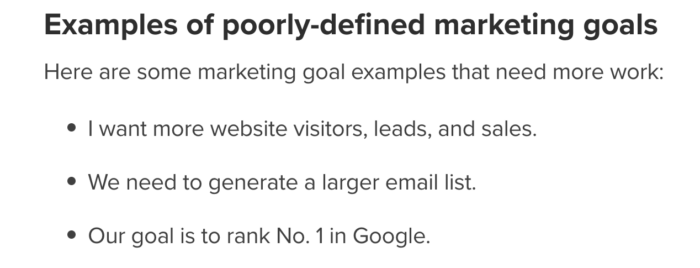
Compare those poorly designed goals to these SMART examples:
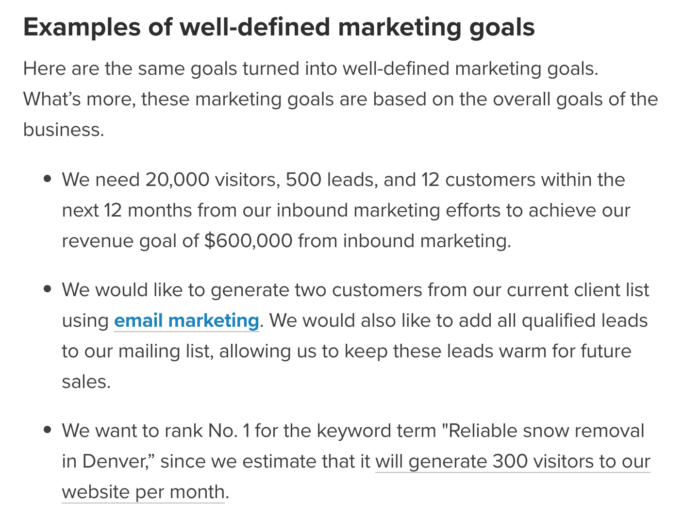
See the difference?
Sharpen your goals to focus your marketing efforts. Otherwise, you’ll get stuck down the road because you didn’t pause to think about what you’re trying to achieve. Or worse, you’ll end up lost and disappointed.
When planning your content goals, ask yourself:
- What are your biggest pain points?
- What do you want to achieve?
- What tactics could you use to get there?
- Where are your competitors falling flat?
- How will these goals play into your greater objectives for your firm?
These answers will guide you to successful website content. From here, you can develop and implement your marketing efforts.
And that’s how you’ll get so many leads, you’ll need more staff to keep up.
Step #2: Create a quarterly content plan.
Once you’ve defined your goals, determine what kind of content you’ll create to achieve them. You’ll want to use more than one platform to reach your potential clients. People can seek the same information but look for it in different places.
Spread your content across platforms to create a web of content that links back to your firm, and funnels leads to your inbox.
Think about which platform will best support each of your goals:
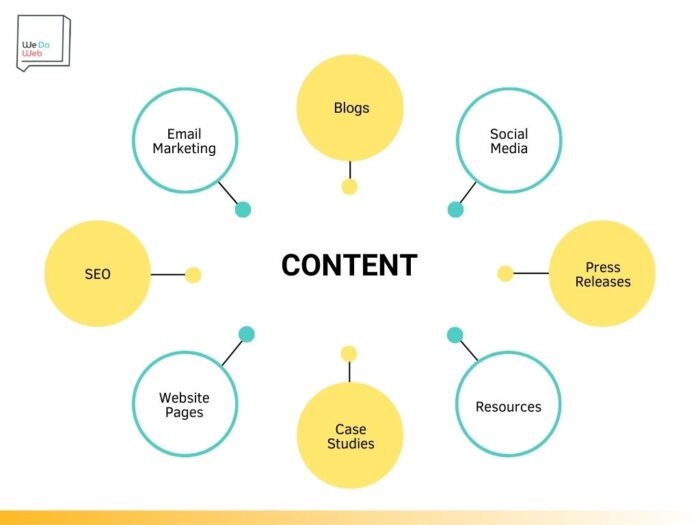
Post case studies on your website and shoot them off in your newsletter once in a while. Announce press releases on Facebook and leave them on your website for people to refer to later.
Regardless of the content types you choose, focus on topics that resonate with your clients. People will scroll past even the most fine-tuned Linkedin post if they can’t relate to it.
Don’t let leads fall through the cracks.
Your content plan is your road map to reaching your greater business goals. Don’t try to juggle your road map with everything else you’re already doing.
Outline a publishing schedule, also known as an editorial calendar. Your editorial calendar is a bird’s eye view of the posts you’ll publish on each platform.
It allows you to stay organized and identify gaps in your approach. Gaps = missed opportunities to reach people.
Here’s an example of an editorial calendar from digital advertising experts at Mintent:
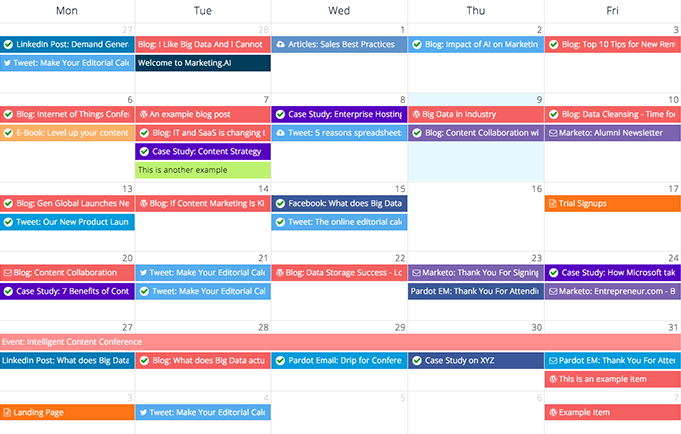
Scheduling your content keeps you on track to reach your goals.
Get a head start with this free editorial calendar template from inbound marketing frontrunner Hubspot. You’ll be planning your way to a predictable flow of new clients each month in no time.
Step #3: Write and optimize your content.
You have your ideal client in mind. You have your plan in place.
Now it’s time to start writing your legal website content.
For each post, figure out exactly where your reader is in their decision-making journey. In other words, how close they are to deciding to hire you.
Use this as a reference:
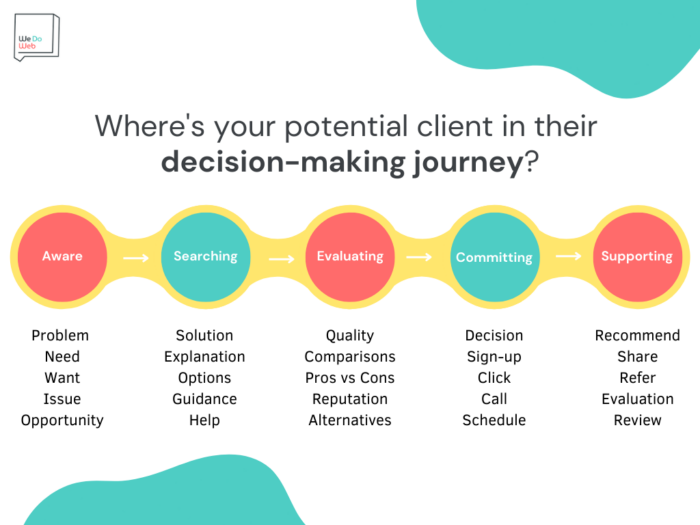
You’ll reach more people when you choose topics that relate to people in different stages of the decision-making journey.
For example, write a Facebook post promoting one of your service areas and speak to someone in the “awareness” stage.
Reach someone in the “searching” stage by creating an informational graphic for your website and write a blog post explaining it.
You’re covering multiple bases when you offer different levels of support.
Here’s an example of content geared toward people in the “searching” stage from FreemanHarris law firm:
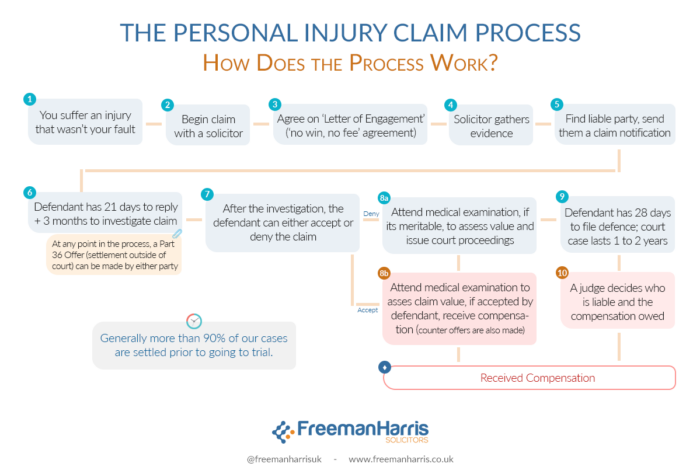
This graphic won’t impact someone who doesn’t know if they need a personal injury lawyer. You can reach that person by publishing your bio and explaining the types of cases you handle. They’ll not only see that they need a personal injury lawyer but that they need you.
Mix up the purpose behind your content and turn more people seeking help into your clients.
But don’t stop there:
Reach as many people as possible
By optimizing your content, you’re writing in a way that reaches people who use search engines like Google to find information.
(Fun fact: Google is top dawg when it comes to search engines, with over 86% of the search market share, according to SEJ. That’s who you’re out to impress with your content.)
Google scans content for specific words, called keywords, that match its users’ search queries. When your content is highly relevant to a keyword, Google rewards it with a spot on its first page, making it easier for people to see it.
Search engine consultants at Platonik found that less than 12% of people click to the second page search results.
Here’s the truth:
If your content isn’t among the top results on Google for your firm’s most important keywords, no one’s reading it.
The better you optimize your content, the better your chances are of landing on Google’s first page. And, the more content you have on page 1 for various keywords, the better your ROI.
Start by finding keywords for your topics using a platform like Semrush.
Then, add your keywords to the areas Google looks at most:
- Page title
- Paragraph headings
- Meta description (the summary of your content shown in Google’s search results)
- First 100 words
- Image alt text (the text alternative of an image)
Through comprehensive marketing research, SmallBizGenius reports that 51% of all website traffic comes from organic searches. Search Engine Optimization (SEO) brings in these organic, or non-sponsored, searches.
Optimize your content, and your phone will ring constantly with the types and quality of cases you want.
What’s next? Publish content consistently
Google likes consistency the same way it likes keywords. You want Google to recognize your posting pattern and deem you a reliable source of information.
It’ll start sending your content to the top of its search results once it does. Use your editorial calendar to stay on schedule.
But remember:
Google isn’t your ideal client.
Write so Google recognizes your content, but always write to your potential client.
Readers value consistency, too. When someone can rely on your content, they can trust you. And then they hire you.
So now your law firm website content writing to-do list reads:
- Learn your ideal client’s deepest desires
- Determine a list of SMART goals
- Outline a detailed content plan
- Create an editorial calendar every month
- Write for different people across several platforms
- Optimize everything you write
- Post your content consistently
That’s a lot to take on. But if you don’t prioritize your website content, you’re giving away cases to other lawyers who do.
It doesn’t have to take over your life, though.
Don’t stress over your law firm website content writing.
You can get more people reading your content – without having to be hands-on throughout the process.
How?
Hire a team whose only job is writing content for lawyer websites.
Leading educators from The Content Marketing Institute found that 55% of B2C marketers outsource content marketing.
That’s because it’s labor-intensive, but the results are a game-changer.
See for yourself:

We Do Web Content delivers these results.
Our law content marketing team does what we say we’ll do and we’ll do it right.
You have enough to supervise. Don’t waste your firm’s growth potential or time with your family because you’re stuck dealing with the small stuff (like overseeing what pages are being published and when).
Take back your brain space. Call (954) 425-9081 or reach out to us here.

Yvette Valencia is the Latina founder and CEO2 of We Do Web Content, a content marketing agency for law firms and one of Inc. 5000’s fastest-growing private businesses in America. She’s a 14-year content marketing veteran and Six Sigma-certified Green Belt credited with developing the proven (and repeatable) process for creating top-ranking website content at scale for attorneys.

